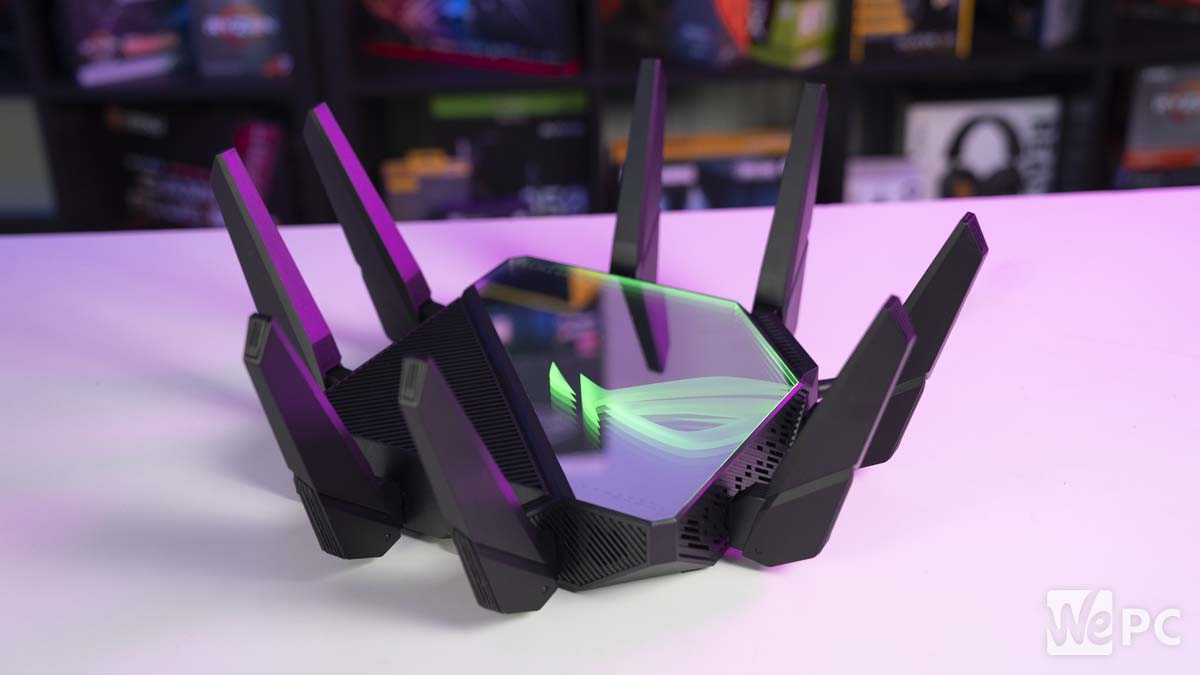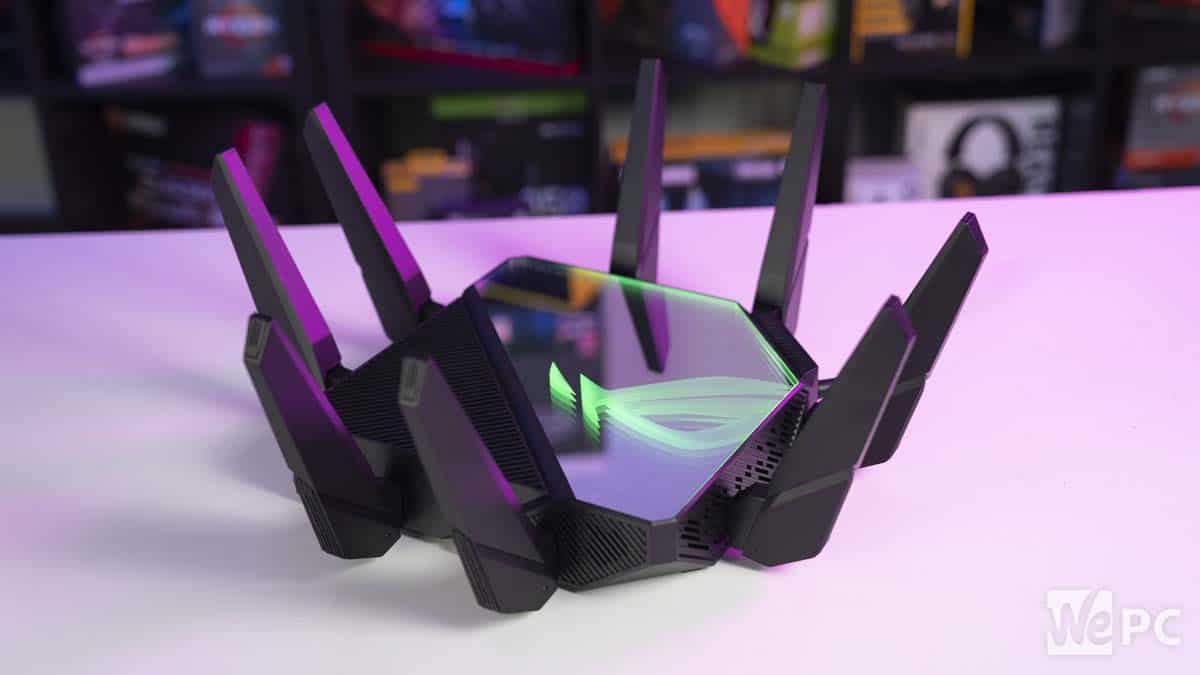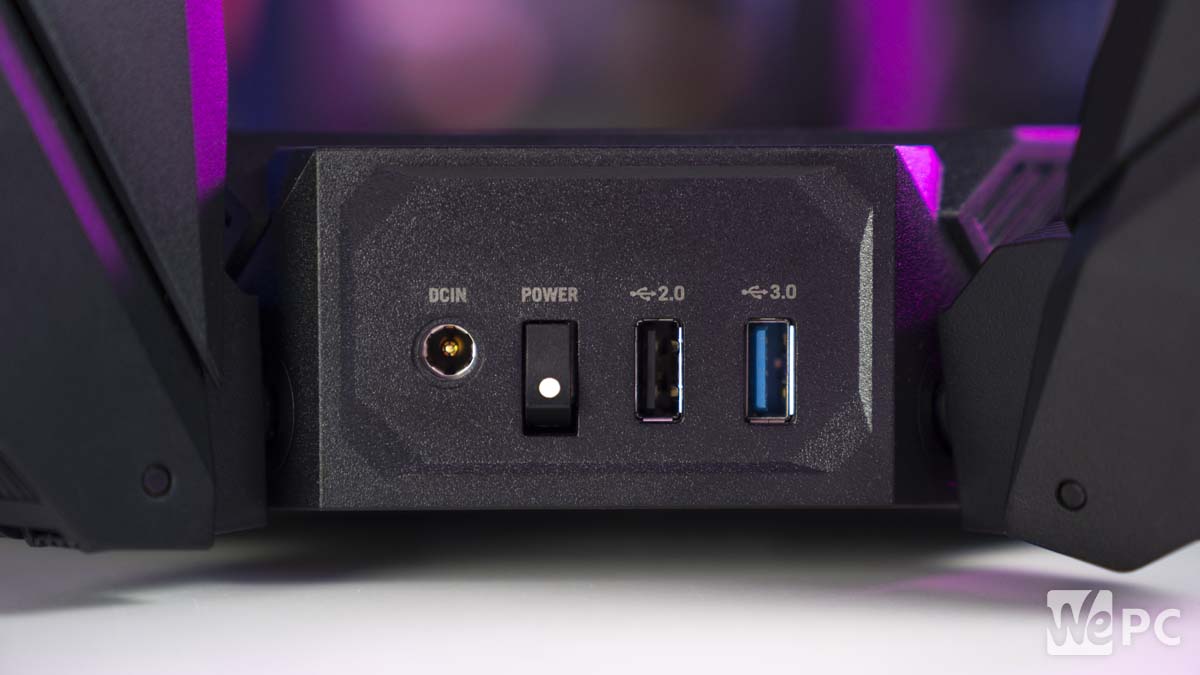
Is this premium WiFi 6E gaming router worth your money?
Updated: Apr 14, 2024 12:44 pm

WePC is reader-supported. When you buy through links on our site, we may earn an affiliate commission. Prices subject to change. Learn more
The ASUS ROG Rapture GT-AXE16000 is yet another very high-end gaming router from the Taiwanese tech giant. The company is absolutely dominating the premium gaming market, with very little competition from other brands, yet they keep on putting them out, not that we’re complaining!
Read below for our look over the features of this device, plus the results of our performance testing.
Pros
-
high bandwidth quad-band WiFi -
multiple high Gbps ethernet connections -
fast processor -
ASUS Ai mesh technology -
feature rich software
Cons
-
expensive at full price -
file transfer speeds via WiFi are a bit underwhelming -
no longer the latest WiFi standard -
a big, garish device that takes up a lot of space
1x 2.4GHz (1,148 Mbps), 2x 5GHz (4,804 Mbps), 1x 6GHz (4,804 Mbps)
2GB DDR4 RAM + 256MB flash memory
1x USB 2.0 Type-A, 1x USB 3.2 Gen 1 Type-C
Overall Design
Previous
Next
As is common among ASUS gaming routers released over the last couple of years, the GT-AXE16000 has a spider-like appearance with eight antennas designed to maximize Wi-Fi coverage. Half of the top of the router is covered by a reflective mirrored panel, which we must say attracts smudges extremely easily, and reflects the lights from the router and any other source: this is not a subtle looking device in any respect, including its size, which is enormous, making where to conveniently place it a possible issue.
The router has quad-band frequencies: one 2.4GHz, two 5GHz, and one 6GHz (for those WiFi 6E and WiFi 7 devices that can utilise it), with a combined maximum (theoretical) bandwidth of around 16,000Mbps (or 16Gbps), hence the name GT-AXE16000.
The WAN connection, which for the uninitiated links to your external broadband connection, has a 2.5Gbps bandwidth, which means this is the effective peak internet bandwidth you can achieve, though this is still well above what most people in most of the world have access to.
Besides the WAN port, you get six ethernet ports that can be used to set up LAN connections: four of these have a 1Gbps bandwidth, whereas two go all the way up to 10Gbps – obviously well beyond the broadband WAN input but potentially useful for data transference if you’re shifting some seriously large file sizes. Link aggregation is also supported if you wish to combine two of the 1Gbps cables together into a single 2Gbps data channel.
Other features
Like all recent high-end ASUS routers, the ROG Rapture GT-AXE16000 comes with AiMesh technology, meaning you can setup a mesh network between different ASUS routers that have this feature, without them needing to be the same model like you typically would with most other brands.
The router comes with the typical WiFi 6E features you’d expect like MU-MIMO data streaming, WPA3 encryption, OFDMA, Target Wake Time, a maximum 160MHz channel bandwidth, and 1,024 Quadrature Amplitude Modulation (QAM). You also get gamer-focused QOS features designed to prioritize gaming bandwidth over any other users of your network, ensuring minimal performance drops.
In terms of the onboard software, the mobile app you can download to manage the router is actually quite intuitive and well designed – a refreshing change from say the ASUS Armoury Crate software you find on laptops. Within the settings you can configure your standard Wi-Fi, WAN, and LAN settings, plus set up different web filters for different age groups within the Family menu, edit general security options, view the devices on your network and your typical diagnostic information, and more.

Pricing
When it originally went on sale back in 2022, the GT-AXE1600 had an MSRP of $699.99, which was rightly considered to be a very high asking price by most reviewers at the time. The price has dropped to $599.99 since then and we’d still consider this a steep asking price given 6E is no longer the latest WiFi standard (though still perfectly fine for the vast majority off users), however we’ve seen it on offer for $499.99 of late, and this is a lot more reasonable for a premium gaming router.
Performance
The maximum bandwidth of our internet is unfortunately not sufficient to test the capabilities of the router to reach the claimed maximum Mbps on the different frequency bandwidths (the max we can get is around 280Mbps). What we could do however is conduct a signal strength test at various distances.
In layman’s terms, a weaker signal effectively means you’ll enjoy a lower percentage of the bandwidth, and will give you a decent indication of how far the effective range of the router will be for your needs.
We also tested the read and wire speeds of the router when doing file transfers. This should help give you an idea of the effective ability of the router to move files via the LAN connections.
Signal strength test
Signal strength is measured in dBm (decibel milliwatts). It’s not immediately intuitive how the measuring system works but -30 dBm is the perfect result for a signal at one end of the scale, with around the -90 dBm mark typically signifying disconnection at the bottom end: the better results are those closer to -30 dBm, though anything around the -50 dBm to -67 dBm range is considered good.
As you can see below the best results were those taken 10 feet away from the router, as you’d expect, without much difference between the different frequency bands. At 30 feet away (with no obstructions) and 60 feet away (with a single wall in the way), the results were well within the -50 dBm to -67 dBm window.
At 90 feet away with two walls between the device and the router, we noticed significant differences between the different frequency bands, with the 2.4GHz band performing best as is typical due to the higher penetration of its frequency, the 5Ghz band just barely getting through, and the 6GHz channel struggling to make a connection (it alternated between a very poor connection around 50% of the time and being completely disconnected for the other half). At these distances then (with this many walls in the way), you can only really rely on the 2.4GHz band.
| Distance | 2.4GHz | 5GHz | 6GHz |
| 10ft (clear line of sight) | -41dBm | -40dBm | -44dBm |
| 30ft (clear line of sight) | -54dBm | -52dBm | -56dBm |
| 60ft (1x blocking wall) | -60dBm | -59dBm | -59dBm |
| 90ft (2x blocking walls) | -75dBm | -87dBm | couldn’t connect / -92dBm |
File transfer test
To test the utility of the GT-AXE1600 WiFi from a file sharing perspective, we connected our testing laptop via WiFi (using the 5GHz band) to the router and then connected an SSD to the router via a USB-C 3.0 connection to the port on the router. We had the laptop placed around 10 foot away. We then tested the bit rate when transferring an 18GB file (specifically a game file from the Assassin’s Creed Valhalla folder) from the laptop to the SSD (the Write speed), and then back again (the Read speed).
These aren’t the best results we must say, and we were hoping for an additional 10-15Mbps higher to keep it in line with the competition (including from ASUS’ own Netgear RAXE500), however the positive is that you’ll get monstrously high speeds going ethernet to ethernet and using the two 10Gbps connections.
| Write test | Read test |
| 49 Mbps | 46 Mbps |
Should you buy the ASUS ROG Rapture GT-AXE1600?
For the average gamer, even a competitive gamer, buying the ROG Rapture GT-AXE1600 would be complete overkill, given most of its features just would not be used. Whilst it’s definitely fast, there are cheaper models out there that have the 2.5Gbps WAN socket to maximise the performance benefits of fibre optic broadband connections; we’d recommend the older Asus ROG Rapture GT-AX6000 if you don’t mind being limited to WiFi 6.
Where it comes into its own is if you’re planning on transferring large files quickly between different computers in the same LAN network, so you can take full advantage of the 10Gbps ethernet ports along with the 1Gbps connections. Creatives working in the same physical space who wish to move large video files would find this very useful, you’ll be able to shift 8K footage around like no one’s business, and it could be used to set-up a network storage bank (a NAS for instance). Alternatively if you’re looking to set up a LAN gaming network or some other creative server setup this could be the pick for you, although if that’s the case you may want to opt for a WiFi 7 router instead; we’d at least wait until you see the price of this device come down from the current $599.99 asking price.


















